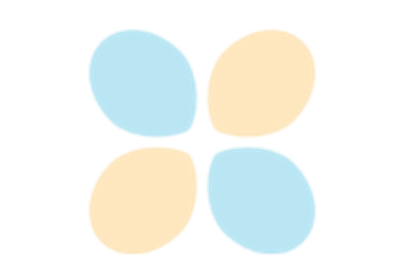Note
Go to the end to download the full example code or to run this example in your browser via JupyterLite or Binder.
Inductive Clustering#
Clustering can be expensive, especially when our dataset contains millions of datapoints. Many clustering algorithms are not inductive and so cannot be directly applied to new data samples without recomputing the clustering, which may be intractable. Instead, we can use clustering to then learn an inductive model with a classifier, which has several benefits:
it allows the clusters to scale and apply to new data
unlike re-fitting the clusters to new samples, it makes sure the labelling procedure is consistent over time
it allows us to use the inferential capabilities of the classifier to describe or explain the clusters
This example illustrates a generic implementation of a meta-estimator which extends clustering by inducing a classifier from the cluster labels.
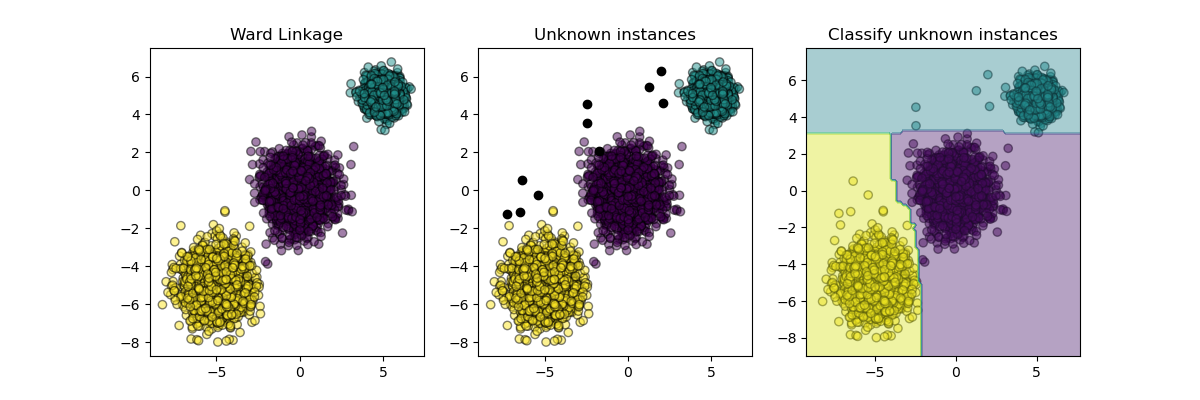
# Authors: The scikit-learn developers
# SPDX-License-Identifier: BSD-3-Clause
import matplotlib.pyplot as plt
from sklearn.base import BaseEstimator, clone
from sklearn.cluster import AgglomerativeClustering
from sklearn.datasets import make_blobs
from sklearn.ensemble import RandomForestClassifier
from sklearn.inspection import DecisionBoundaryDisplay
from sklearn.utils.metaestimators import available_if
from sklearn.utils.validation import check_is_fitted
N_SAMPLES = 5000
RANDOM_STATE = 42
def _classifier_has(attr):
"""Check if we can delegate a method to the underlying classifier.
First, we check the first fitted classifier if available, otherwise we
check the unfitted classifier.
"""
return lambda estimator: (
hasattr(estimator.classifier_, attr)
if hasattr(estimator, "classifier_")
else hasattr(estimator.classifier, attr)
)
class InductiveClusterer(BaseEstimator):
def __init__(self, clusterer, classifier):
self.clusterer = clusterer
self.classifier = classifier
def fit(self, X, y=None):
self.clusterer_ = clone(self.clusterer)
self.classifier_ = clone(self.classifier)
y = self.clusterer_.fit_predict(X)
self.classifier_.fit(X, y)
return self
@available_if(_classifier_has("predict"))
def predict(self, X):
check_is_fitted(self)
return self.classifier_.predict(X)
@available_if(_classifier_has("decision_function"))
def decision_function(self, X):
check_is_fitted(self)
return self.classifier_.decision_function(X)
def plot_scatter(X, color, alpha=0.5):
return plt.scatter(X[:, 0], X[:, 1], c=color, alpha=alpha, edgecolor="k")
# Generate some training data from clustering
X, y = make_blobs(
n_samples=N_SAMPLES,
cluster_std=[1.0, 1.0, 0.5],
centers=[(-5, -5), (0, 0), (5, 5)],
random_state=RANDOM_STATE,
)
# Train a clustering algorithm on the training data and get the cluster labels
clusterer = AgglomerativeClustering(n_clusters=3)
cluster_labels = clusterer.fit_predict(X)
plt.figure(figsize=(12, 4))
plt.subplot(131)
plot_scatter(X, cluster_labels)
plt.title("Ward Linkage")
# Generate new samples and plot them along with the original dataset
X_new, y_new = make_blobs(
n_samples=10, centers=[(-7, -1), (-2, 4), (3, 6)], random_state=RANDOM_STATE
)
plt.subplot(132)
plot_scatter(X, cluster_labels)
plot_scatter(X_new, "black", 1)
plt.title("Unknown instances")
# Declare the inductive learning model that it will be used to
# predict cluster membership for unknown instances
classifier = RandomForestClassifier(random_state=RANDOM_STATE)
inductive_learner = InductiveClusterer(clusterer, classifier).fit(X)
probable_clusters = inductive_learner.predict(X_new)
ax = plt.subplot(133)
plot_scatter(X, cluster_labels)
plot_scatter(X_new, probable_clusters)
# Plotting decision regions
DecisionBoundaryDisplay.from_estimator(
inductive_learner, X, response_method="predict", alpha=0.4, ax=ax
)
plt.title("Classify unknown instances")
plt.show()
Total running time of the script: (0 minutes 6.952 seconds)
Related examples
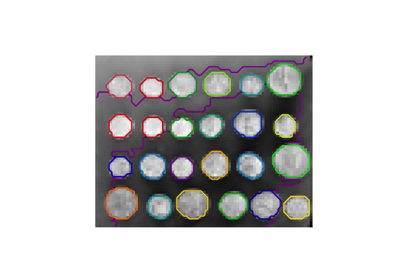
A demo of structured Ward hierarchical clustering on an image of coins
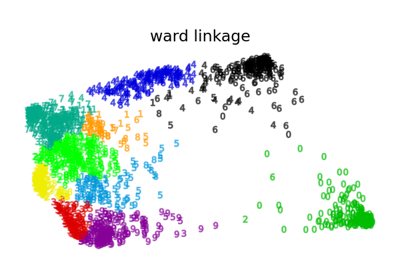
Various Agglomerative Clustering on a 2D embedding of digits
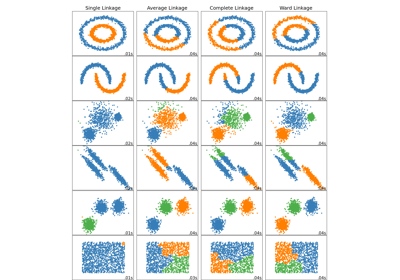
Comparing different hierarchical linkage methods on toy datasets
